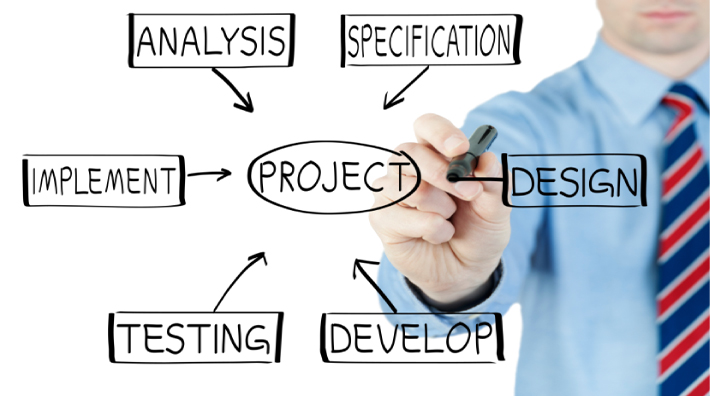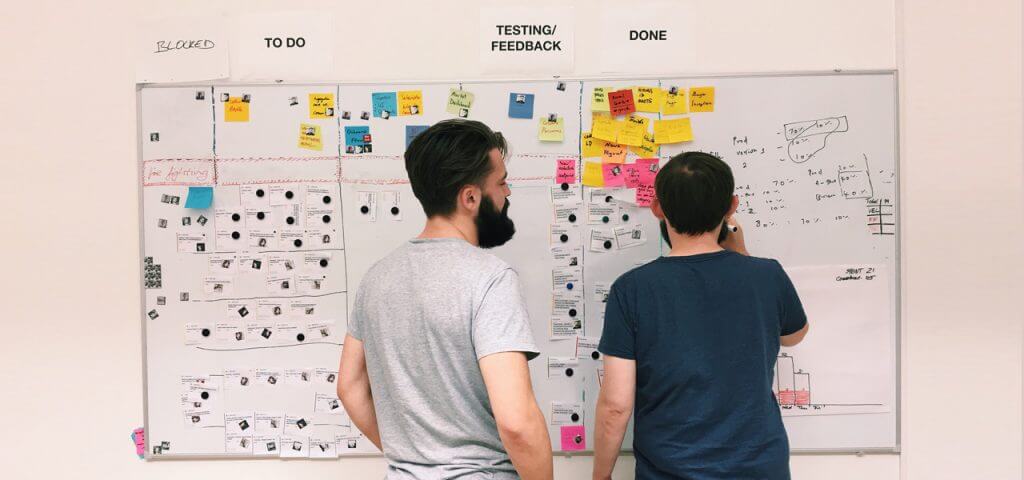The tech methodology that’s used to create your mobile or Web-based product can make a big difference in the results you’ll enjoy when all is said and done. The tech structure of your application is equally essential to the user experience (UX).
Venture Aviator utilizes multiple methodologies to achieve client-specific goals and create an appealing product for the intended end-user. Here are some of the primary methodologies we use at Venture Aviator as part of our custom software development services.
Agile Methodology
Agile is a product development approach we adhere to at Venture Aviator because it often results in a satisfying customer experience. The Agile methodology segments the development process into different stages known as the Agile development cycle. Our Agile developers divide one main task into several sub-tasks. Each of the sub-tasks then becomes a separate module for our Agile development team.
The Agile development cycle is structured in a way that allows for adaptability to changing product requirements. This structure is appealing to our developers and many of our clients since other methodologies like Kanban and Scrum can be incorporated along the way.
Venture Aviator’s Agile developers follow a flow that includes:
• Envisioning and prioritizing project concepts
• Putting together teams and determining initial requirements
• Delivering the product based on established requirements and feedback
• QA testing prior to release
• Ongoing software support
• End-of-life activities (e.g., customer notification or migration)
Agile software development can be especially beneficial for clients available to provide consistent input. Our Agile developers have the flexibility that’s necessary to quickly accommodate changes, which is easier to do when development is structured into individual tasks rather than one large project.
Have Immediate Software Development Needs? Click here to tell us about them
Scrum Methodology
The Scrum methodology is considered to be part of the “Agile development movement.” Specifically, it’s a management and control process that keeps the focus on creating and developing projects with client-specific needs in mind. Because it’s a simple framework, Scrum development can be an effective way to handle team collaboration on complex projects.
Scrum software development is completed with a cross-functional team. Essentially, everyone on the team is a Scum expert, meaning there is no single team leader who will make project decisions since everyone offers unique skills and insights.
Within an Agile development set-up, however, there are three specific roles. There’s a Scrum master. The Scrum master acts as sort of a coach for the team. The role of the Scrum master is to help other team members implement the Scrum software development process as efficiently and effectively as possible from start to finish. They also shelter the team from outside distractions so the focus can stay on the tasks at hand.
The second role is filled by everyone on the Scrum team. While individuals may have specific tasks, everyone contributes equally to complete each sprint. And the final role on a Scrum team is the client, or product owner. We always put clients first at Venture Aviator, so it’s easy to see why we deploy collaborative efforts of this nature.
Scrum vs Agile
Scrum development is a framework we often use at Venture Aviator to implement Agile development projects. Since both methodologies are often related and intertwined, the best way to do a Scrum vs Agile comparison is to look at what Scrum adds to Agile.
Scrum provides structure. Agile can exist without elements of Scrum in place. You can make an argument that Agile without Scrum used for guidance may result in a more scattered or less organized approach to development.
One of the most challenging aspects of any app development project is the interplay among team members. So, making Scrum part of the process can result in a better Agile experience.
Waterfall Methodology
The Waterfall methodology is a sequential software development model that’s so-named because the steps are done in a “waterfall-like” style. Waterfall software development starts with an idea and an introduction where the specific concept for the software being created is discussed with our team. The Waterfall development process continues to include:
• A detailed analysis of the software concept
• A comprehensive approach to design and development
• Testing throughout every stage of the waterfall development process
• Implementation and ongoing maintenance
Agile Mythodology vs Waterfall Methodology
Waterfall software development is appealing because there’s well-built documentation and meticulous record-keeping involved. This can make the product better when adjustments are necessary in the future as needs change.
However, Waterfall development requires that steps be followed in order. Waterfall development is a sequential software development process where the specs are laid out ahead of time. Developers do not skip ahead in the Waterfall software development process. As a result, it’s hard and costly to go back once waterfall software development steps have been completed. If you know what you want this is the fastest way to build it.
With Waterfall, testing is done at the end, so any bugs will be discovered after all steps have been completed. The biggest advantage with Waterfall software development is that everybody involved will know the specific project end goals from the beginning.
The Agile model addresses the shortcomings of the Waterfall method. Overall, we think it is a more efficient way to manage software development. With Agile, our developers start with a base design and move to smaller modules as development advances. The work can be conveniently broken down into monthly or weekly sprints which allows bugs and errors to be found before moving onto the next sprint.
One of the many advantages of software development outsourcing with Venture Aviator is that our team can identify which methods will likely work for your project before any work is done. Outsourcing development to us also means you won’t have to rely on one single methodology that may have limitations.
Test Driven Design
The purpose of test driven design (TDD) is to write clean code that works well enough so it passes the performed test. It’s a process that involves writing functional code and testing after that code is written. Developers write an automated test case that initially fails. Then the minimum amount of code to pass that test is written, tested and refactored.
Test driven design is a repetitious design process where code is written and tested at every stage of mobile or web development. Since tests are conducted from the beginning of the design cycle, we can save our clients time and money with TDD by minimizing debugging issues in later stages. TDD is a way to make an MVP with agile development.
Kanban Methodology
Japanese for “visual signal,” Kanban is a visual framework. The Kanban methodology is often used to implement Agile. Kanban software development is an approach to product creation that encourages incremental changes to an established system. It does not, however, require a specific set of procedures. This allows Kanban to be easily incorporated within existing workflows.
Kanban software development applies elements of Toyota’s “Just-In-Time” product system to the development process to deliver what’s needed when it’s needed. It involves the use of a tool referred to as a Kanban board, which consists of several columns dedicated to different aspects of the development process. There might be one column for coding, another one for testing and another one for backlog. The Kanban methodology has the potential to improve workflow and reduce cycle time for the following reasons:
• It’s a flexible, fluid model with no set phase durations
• Kanban reduces waste by eliminating work that doesn’t need to be done
• Because of its visual nature, Kanban is easy to understand and implement
• It improves workflow with tactics that include continuous delivery
• With a Kanban set-up, everyone on the team works to get things done on time
Kanban vs Agile
When considering Kanban vs Agile, keep in mind that Kanban is essentially one piece of the Agile pie. A common drawback of Kanban is that there are no timeframes associated with each phase of the project listed on the visual board. Boards can sometimes get complicated if team members keep adding steps or tasks to each column.
Agile typically involves iterations or sprints of a fixed duration. Kanban has no durations. If Agile is set up with Scrum, there will be specific roles on the team. Kanban, by itself, does not work on the basis of roles. Kanban also allows for more flexibility with the ability to make changes at any moment.
Some projects we undertake at Venture Aviator are done with Kanban as the underlying methodology. Other projects may combine Agile with different methodologies that are more appropriate for what clients have in mind.
Domain Driven Design
Domain driven design (DDD) can be an excellent complement to an agile practice. It’s an approach to developing software for complex needs. DDD means focusing the attention on the heart of the application, which is the business itself. It’s a process that involves:
• A focus on the core domain
• Designs based on models specific to the domain
• Ongoing collaboration with domain experts to improve the application and address any issues related to the domain
Agile Methodology vs Domain Driven Design
DDD isn’t a technology or a methodology. It’s more of a structure of practices that can be applied to specific design approaches like the Agile methodology. With Agile development, project priorities are calculated at the end of every completed task that’s part of the development process. So, if DDD is involved, our Agile developers can make changes based on input from domain experts without affecting the other tasks being complete to get the project finished.
Iterative Methodology
Iterative methodology is a way of breaking down the development process for larger mobile or web applications into smaller stages. With Iterative software development, code is designed, developed, and tested in repetitive cycles. Additional features can be added with each iteration. Design, development, and testing processes will continue with each phase of the project until the application is fully functional.
Agile Methodology vs Iterative Methodology
With Iterative software development, there’s a code, feedback, code cycle that drives the development process. Agile development, on the other hand, has no set template. Iterative development is often associated with Agile. Traditional project methodologies can use iterative development without the need to include other aspects of Agile application development.
Why Choose Venture Aviator?
Custom software development services and solutions that drive success are what you will receive from Venture Aviator. Software development outsourcing means you will have instant access to an Agile and Scrum expert or any other talent you may need to plan and complete your project.
Whether you have an existing product that needs to be updated or you’re starting with nothing more than an idea, we’re committed to turning your ideas into a beautifully functional reality. Outsourcing development to our dedicated team means you can expect:
• Flexibility with service options
• Instant access to development experts
• Timely deliveries
• Diligent testing
• Ongoing communication
• High-quality work
• Budget-friendly options
Thanks to our versatility, mobile app development and Web development can be customized to what’s right for your priorities and budget. Contact Venture Aviator today to discover how we can put the right tech methodologies to work for you.
Have a Software Project You Need Our Help With? Click here to tell us about it


